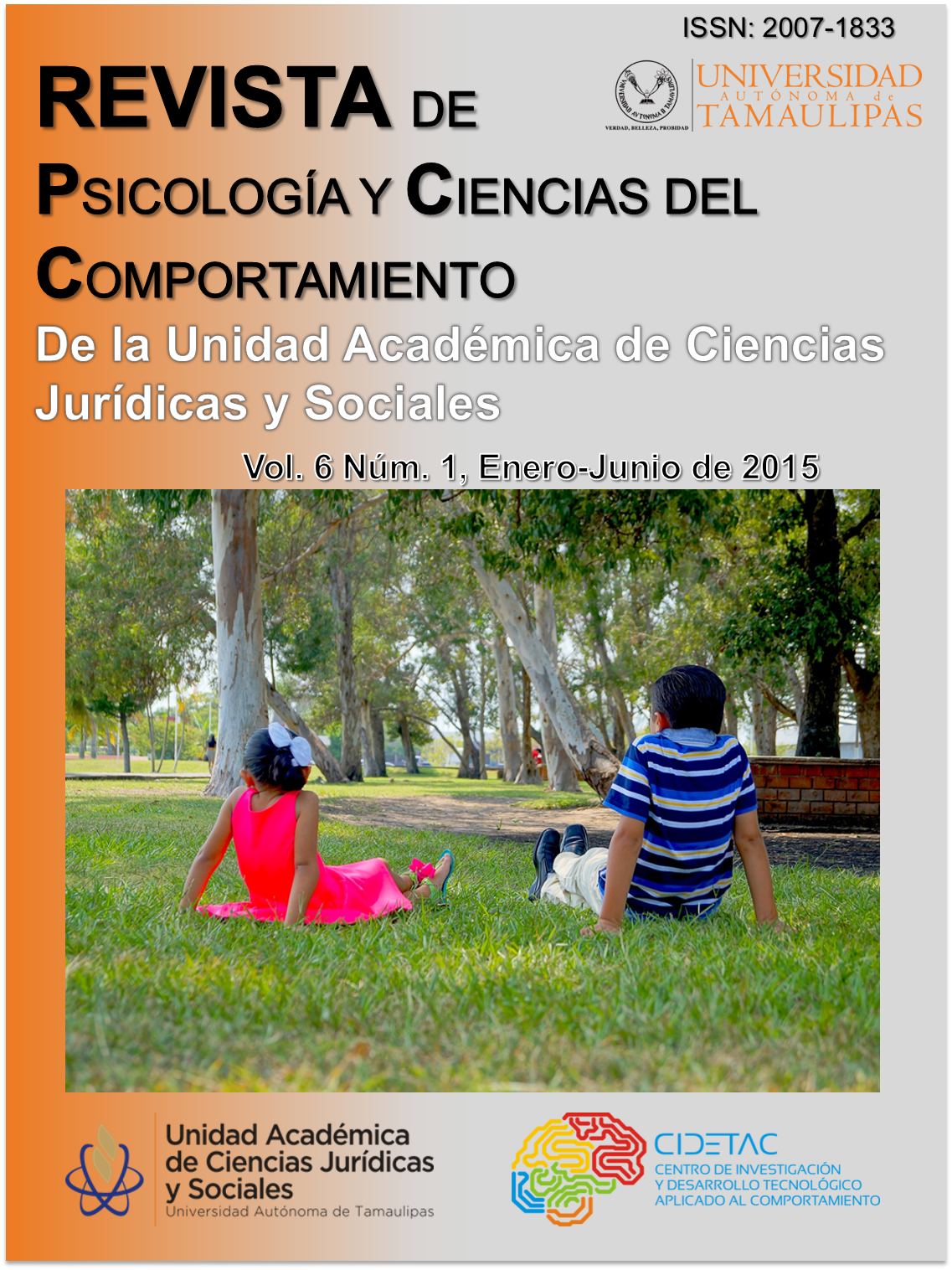Talking to empowerment: a study of a sample of male in northwest Mexico
Keywords:
study of gender, empowerment, self-concept, self-esteem, structural equationAbstract
The members of the communities are potentially enablers of personal and community development. Likewise, empowerment plays an important role in the actions taken by these social actors with gender differences in first place, so the question of the existence of differences addresses the aim of this study to identify the intrapersonal component of a sample of male belonging to an urban population, whose elements are consistent with those raised by a theory of empowerment. 57 people answered a questionnaire with 81 items belonging to the Tennessee and personal agency and empowerment scales. Structural equations were used to identify the intrapersonal component of empowerment composed of self-concept, self-esteem, self-efficacy and empowerment elements. The results obtained from the proposed model supports the theoretical model. It was concluded that the sample of men studied has a positive intrapersonal component that differs from that characterized the sample of women, suggesting that in the first instance building actions for the population must be directed towards the female gender.References
Bandura, A. (2002). Social cognitive theory in cultural context. Applied Psychology: An International Review. 51, (2), 269-290.
Banda, A. L. y Morales, M. A. (2015). Empoderamiento psicológico: un modelo sistémico con componentes individuales y comunitarios. Revista de Psicología de la Pontificia Universidad Católica del Perú. 33, (1), 3-10.
Bennett, L. y Chapman, A. R. (2010). The process of empowerment. American Psychologist. 65, (7), 646-659.
Christens, B. D., Speer, P. W. y Peterson, N. A. (2011). Social class as moderator of the relationship between (dis) empowering processes and psychological empowerment. Journal of Community Psychology. 39, (2), 170-182.
Christens, B. D. (2012). Toward relational empowerment. American Journal of Community Psychology. 50, (1-2), 114-128.
Closas, A. H., Arriola, E. A., Kuc, C. I., Amarilla, M. R. y Jovanovich, E. C. (2013). Análisis multivariante, conceptos y aplicaciones en psicología educativa y psicometría. Enfoques. XXV, (1), 65-92.
Ferrando, P. J. y Anguiano, C. (2010). El análisis factorial como técnica de investigación en psicología. Papeles del Psicólogo. 31, (1), 18-33.
Herrero, J. (2010). El análisis factorial confirmatorio en el estudio de la estructura y estabilidad de los instrumentos de evaluación: un ejemplo con el cuestionario de autoestima CA-14. Psychosocial Intervention. 19, (3), 289-300.
Itzhaky, H. y York, A.S. (2000). Empowerment and community participation: does gender make a difference?. Social Work Research. 24, (4), 225-234.
McWhirter, B. y McWhirter, E. (2006). Empoderamiento de parejas y familias a través de la integración de la psicología y la educación popular. Revista de Psicología de la Universidad de Chile. XV, (1), 73-88.
Maton, K. I. (2008). Empowering community settings: agents of individual development, community betterment and positive social change. American Journal of Community Psychology. 41, (1-2), 4-21.
Montero, M. (2009a). El fortalecimiento en la comunidad, sus dificultades y alcances. Universitas Psychologica. 8, (3), 615-626.
Montero, M. (2009b). Community action and research as citizenship construction. American Journal of Community Psychology. 43, (1-2), 149-161.
Pardo, M. L., Pineda, S., Carrillo, S. y Castro, J. (2006). Análisis psicométrico del inventario de apego con padres y pares en una muestra de adolescentes colombianos. Revista Interamericana de
Peterson, N. A. y Hugley, J. (2004). Social cohesion and intrapersonal empowerment: gender as moderator. Health Education Research. 19, (5), 533-542.
Peterson, N. A., Lowe, J. B. y Aquilino, M. L. (2005). Linking social cohesion and gender to intrapersonal and interactional empowerment: support and new implications for theory. Journal of Community Psychology. 33, (2), 233-244.
Peterson, N. A., Lowe, J. B., Hughey, J., Teid, R. J., Zimmerman, M. A. y Speer, P. W. (2006). Measuring the intrapersonal component of psychological empowerment: confirmatory analysis of the sociopolitical control scale. American Journal of Community Psychology. 38, (3-4), 287-297.
Ruíz, M. A., Pardo, A. y San Martín, R. (2010). Modelos de ecuaciones estructurales. Papeles del Psicólogo. 31, (1), 34-45.
Sánchez, A. (2013). ¿Es posible el empoderamiento en tiempos de crisis? Repensando el desarrollo humano en el nuevo siglo. Universitas Psychologica. 12, (1), 285-300.
Sánchez, E. (1999). Relación entre la autoestima personal, la autoestima colectiva y la participación en la comunidad. Anales de Psicología. 15, (2), 251- 260.
Silva, C. L. y Martínez, M. L. (2007). Empoderamiento, participación y autoconcepto de persona socialmente comprometida en adolescentes chilenos. Interamerican Journal of Psychology. 41, (2), 129-138.
Speer, P. Peterson, N. Armstead, T. y Allen, C. (2013). The influence of participation, gender and organizational sense of community on Psychological Empowerment: The moderating effects of income.
American Journal of Community Psychology. 51, (1-2), 103-113.
Wang, Q., Chen, X. y Chen, Y. (2011). Development of a scale to measure residents’ psychological empowerment in Chinese urban community. Journal of Community Psychology. 39, (2), 202-211.
Wothke, W. (2010). Introduction to Structural Equation Modeling Course Notes. Carolina del Norte: SAS Institute Inc. 64 Pp.
Zimmerman, M. A. (2000). Empowerment theory: psychological, organizational and community levels of analysis. In J. Rappaport y E. Seidman (Eds.), Handbook of community psychology (pp. 43-63). New York: Plenum Press.
Downloads
Published
Issue
Section
License
Those authors who have publications with the Journal of Psychology and Behavioral Sciences of the Academic Unit of Legal and Social Sciences, accept the following terms:
a. The authors will retain their copyright and guarantee the journal the right to first publish their work, which will be simultaneously subject to the Creative Commons Attribution-NonCommercial-Share Alike 4.0 International License. which allows third parties to share the work as long as its author and his first publication are indicated this journal.
b. Authors may adopt other non-exclusive license agreements for the distribution of the version of the published work (e.g., deposit it in an institutional telematic archive or publish it in a monographic volume) provided that the initial publication in this journal is indicated.
C. Authors are allowed and recommended to disseminate their work through personal communication (e.g. colleagues) before and during the submission process, for purposes of feedback or enrichment of the work, which can produce interesting exchanges
Accepted 2015-11-02
Published 2015-05-29








